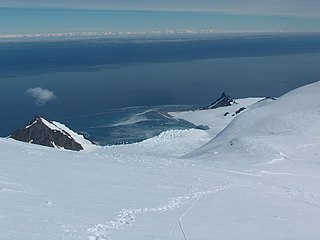Related Research Articles

In marine geology, a guyot, also called a tablemount, is an isolated underwater volcanic mountain (seamount) with a flat top more than 200 m (660 ft) below the surface of the sea. The diameters of these flat summits can exceed 10 km (6 mi). Guyots are most commonly found in the Pacific Ocean, but they have been identified in all the oceans except the Arctic Ocean. They are analogous to tables on land.

A seamount is a large submarine landform that rises from the ocean floor without reaching the water surface, and thus is not an island, islet, or cliff-rock. Seamounts are typically formed from extinct volcanoes that rise abruptly and are usually found rising from the seafloor to 1,000–4,000 m (3,300–13,100 ft) in height. They are defined by oceanographers as independent features that rise to at least 1,000 m (3,281 ft) above the seafloor, characteristically of conical form. The peaks are often found hundreds to thousands of meters below the surface, and are therefore considered to be within the deep sea. During their evolution over geologic time, the largest seamounts may reach the sea surface where wave action erodes the summit to form a flat surface. After they have subsided and sunk below the sea surface such flat-top seamounts are called "guyots" or "tablemounts".

Bransfield Strait or Fleet Sea is a body of water about 100 kilometres (60 mi) wide extending for 300 miles (500 km) in a general northeast – southwest direction between the South Shetland Islands and the Antarctic Peninsula.

Koko Guyot is a 48.1-million-year-old guyot, a type of underwater volcano with a flat top, which lies near the southern end of the Emperor seamounts, about 200 km (124 mi) north of the "bend" in the volcanic Hawaiian-Emperor seamount chain. Pillow lava has been sampled on the north west flank of Koko Seamount, and the oldest dated lava is 40 million years old. Seismic studies indicate that it is built on a 9 km (6 mi) thick portion of the Pacific Plate. The oldest rock from the north side of Koko Seamount is dated at 52.6 and the south side of Koko at 50.4 million years ago. To the southeast of the bend is Kimmei Seamount at 47.9 million years ago and southeast of it, Daikakuji at 46.7.

The Graveyard Seamounts, officially known as the Graveyard Knolls, are a series of 28 small seamounts and edifices located on the Chatham Rise, east of New Zealand. They cover about 140 km2 (54 sq mi) and stand out from the surrounding oceanic plateau that measures several hundred kilometers. They are named after various morose figures following the naming of the largest of the knolls as "the Graveyard" as it was a graveyard of fishing gear that became stuck on it. The most prominent among the group of knolls are Ghoul, Diabolical, Voodoo, Scroll, Hartless, Pyre, Gothic, Zombie, Mummy, Headstone, Morgue and Graveyard.

Osprey Reef is a submerged atoll in the Coral Sea, northeast of Queensland, Australia. It is part of the Northwestern Group of the Coral Sea Islands. Osprey Reef is roughly oval in shape, measuring 25 by 12 kilometres, and covers around 195 square kilometres (75 sq mi). It has a perimeter of 69.5 kilometres (43.2 mi). The central lagoon is only 30 metres (98 ft) deep.
Methanolobus profundi is a mesophilic, methylotrophic methanogen archaeon. The type strain is MobMT. It was isolated from a deep subsurface gas field.
Thalassotalea is an aerobic and chemo-organo-heterotrophic genus of bacteria from the family Colwelliaceae which occur in the ocean and in sea ice.
Thalassotalea agarivorans is an agarolytic bacterium from the genus of Thalassotalea which has been isolated from coastel water from An-Ping Harbour on Taiwan.
Thalassotalea crassostreae is a Gram-negative, aerobic and rod-shaped bacterium from the genus of Thalassotalea which has been isolated from the oyster Crassostrea gigas from the Yeongheung Island in South Korea.
Thalassotalea eurytherma is a Gram-negative, aerobic and rod-shaped bacterium from the genus of Thalassotalea which has been isolated from seawater from the East China Sea.
Thalassotalea ganghwensis is a Gram-negative, aerobic and halophilic bacterium from the genus of Thalassotalea which has been isolated from tidal flat sediments in Korea.
Thalassotalea loyana is a bacterium from the genus of Thalassotalea. Thalassomonas loyana can cause white plague disease in the coral Favia favus.
Thalassotalea marina is a Gram-negative and facultatively anaerobic bacterium from the genus of Thalassotalea which has been isolated from a recirculating aquaculture system in Tianjin in China.
Thalassotalea montiporae is a Gram-negative, rod-shaped, aerobic and motile bacterium from the genus of Thalassotalea with a single polar flagellum which has been isolated from the coral Montipora aequituberculata from the coast of Taiwan.
Thalassotalea ponticola is a Gram-negative and aerobic bacterium from the genus of Thalassotalea which has been isolated from seawater from the Geoje Island in Korea.
Thalassotalea atypica is a Gram-negative, strictly aerobic and non-spore-forming bacterium from the genus of Thalassotalea which has been isolated from seawater from Rizhao in China.
Thalassotalea coralli is a Gram-negative, aerobic, rod-shaped and motile bacterium from the genus of Thalassotalea which has been isolated from the coral Euphyllia glabrescens.
Ponticaulis profundi is a Gram-negative, strictly aerobic, rod-shaped and motile bacterium from the genus of Ponticaulis which has been isolated from a seamount near the Yap Trench.
Mesoflavibacter profundi is a Gram-negative, aerobic and rod-shaped bacterium from the genus of Mesoflavibacter which has been isolated from a seamount from the northern Mariana Trench.
References
- 1 2 "Thalassotalea". LPSN .
- 1 2 "Thalassotalea profundi". www.uniprot.org.
- ↑ Zhang, De-Chao; Liu, Yan-Xia; Huang, Hai-Jun (23 September 2016). "Novosphingobium profundi sp. nov. isolated from a deep-sea seamount". Antonie van Leeuwenhoek. 110 (1): 19–25. doi:10.1007/s10482-016-0769-3. PMID 27664092. S2CID 7303383.